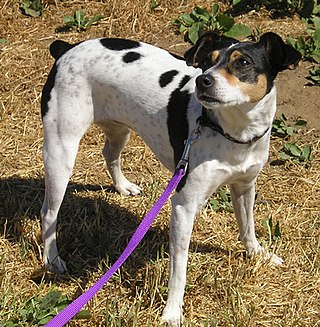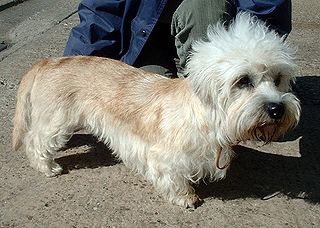
The Fédération Cynologique Internationale is the largest international federation of national kennel clubs and purebred registries. The FCI is based in Thuin, Belgium and has 98 members and contract partners.

The Rat Terrier is an American dog breed with a background as a farm dog and hunting companion. They share much ancestry with the small hunting dogs known as feists. Common throughout family farms in the 1920s and 1930s, they are now recognized by the United (UKC) and American Kennel Clubs (AKC) and are considered a rare breed. Rat Terriers are an intelligent and active breed that can be kept both for pest control and as a family pet.

The Border Terrier is a British breed of small, rough-coated terrier. It originates from the area of the Anglo-Scottish border, and shares ancestry with the Dandie Dinmont Terrier and the Bedlington Terrier from the same area. The dogs were traditionally used in fox-hunting, and worked with the Border Hunt in Northumberland.

A Dandie Dinmont Terrier is a small Scottish dog breed in the terrier family. The breed has a very long body, short legs, and a distinctive topknot of hair on the head. They are friendly but tough, and are suitable for interaction with older children. There are breed-specific health concerns: they can be affected by spinal problems due to their elongated body, and the breed is affected by canine cancer at a higher than average rate.
Toy dog traditionally refers to a very small dog or a grouping of small and very small breeds of dog. A toy dog may be of any of various dog types. Types of dogs referred to as toy dogs may include spaniels, pinschers and terriers that have been bred down in size. Not all toy dogs are lap dogs.

The Japanese Terrier is a small terrier native to Japan. It is believed to be descended from the progeny of fox terrier types, pointers and indigenous Japanese dogs.

The Pinscher is a group of German dog breeds, developed originally as ratters on farms or as guard dogs. In the twenty-first century they are commonly kept as companion animals.

The Australian Silky Terrier or simply Silky Terrier is a small breed of dog of the terrier dog type. The breed was developed in Australia, although the ancestral types and breeds were from Great Britain. It is closely related to the Australian Terrier and the Yorkshire Terrier. The breed is called the Silky Terrier in North America, but is called the Australian Silky Terrier in its country of origin and in the rest of the world.

An earthdog test or earthdog trial tests the working ability and instinct of the small, often short-legged terriers or Dachshunds. These dogs were bred to hunt vermin and other quarry which lived in underground dens. Earthdog den tests involve human-made tunnels that the dogs must navigate, while scenting a rat, "the quarry". The dog must follow the scent to the quarry and then "work" the quarry. Depending on the sanctioning organization, "working" means barking, scratching, staring, pawing, digging; any active behavior. The quarry is protected at all times by wooden bars across the end of the tunnel. The hunting encounter is controlled, and neither the dog nor the quarry are endangered by the activity.

Bull and terrier was a common name for crossbreeds between bulldogs and terriers in the early 1800s. Other names included half-and-halfs and half-breds. It was a time in history when, for thousands of years, dogs were classified by use or function, unlike the modern pets of today that were bred to be conformation show dogs and family pets. Bull and terrier crosses were originally bred to function as fighting dogs for bull- and bear-baiting, and other popular blood sports during the Victorian era. The sport of bull baiting required a dog with attributes such as tenacity and courage, a wide frame with heavy bone, and a muscular, protruding jaw. By crossing bulldogs with various terriers from Ireland and Great Britain, breeders introduced "gameness and agility" into the hybrid mix.

The Basset Bleu de Gascogne, also known as the Blue Gascony Basset, is a long-backed, short legged breed of dog of the hound type. A French native breed, it is rare outside its homeland. It is recognized internationally by the Fédération Cynologique Internationale, in the UK by The Kennel Club, and by the United Kennel Club in the United States. The "bleu" of its name is a reference to its coat which has a ticked appearance.

The Drever is a breed of dog, a short-legged scenthound from Sweden used for hunting deer and other game. The Drever is descended from the Westphalian Dachsbracke, a type of German hound called Bracke. The breed name Drever was chosen through a contest in 1947.

The Transylvanian Hound is a dog breed originating from Hungary and Transylvania and was historically primarily used for hunting. It is a strong, medium-sized scent hound, characterized by a black body, with tan and sometimes white markings on the muzzle, chest and extremities, and distinctive tan eyebrow spots. It has a high-pitched bark for a dog of its size. The breed was rescued from extinction by focused breeding efforts in the late 20th century. There were formerly two varieties, the tall and the short, developed for different kinds of hunting in the Middle Ages. Only the tall variety survives today.

The Russian Toy is a very small breed of dog originally bred in Russia from the English Toy Terrier. There are two types of coats in the breed: smooth coat and long coat. The smooth-coated variety was previously known as the Russian Toy Terrier and long-coated as the Moscow Long-Haired Toy Terrier. Both were brought together under the same Russian Toy Terrier name in 1988 and the "Terrier" was dropped from the name when the breed was added in 2006 to the official list of breeds registered with the Fédération Cynologique Internationale and has been registered in the Foundation Stock Service of the American Kennel Club since 2008, allowed to compete in AKC companion events since 2010. The first official breed standard of the two varieties was written in 1966 in Russia.

The Westphalian Dachsbracke is a small, short-legged scenthound, a breed of dog originating in Westphalia, a region of Germany. The Westphalian Dachsbracke was used in Sweden to develop the Drever.

The Basset Artésien Normand is a short legged hound type dog developed in France. The word basset refers to short-legged hounds.

The Paisley Terrier was a breed of terrier-type dog that is now extinct. Originating in Scotland, the Paisley Terrier was bred primarily as a pet and showdog version of the Skye Terrier, and was the progenitor of today's Yorkshire Terrier. The breed was called the Paisley Terrier since most of the dogs came from that location, but it was also called the Clydesdale Terrier, for another location in the Clyde Valley where the dogs were bred.

The Grand Anglo-Français Blanc et Noir translated into English as the Great Anglo-French White and Black Hound, is a breed of dog used in hunting as a scenthound, usually in packs. It is one of the Anglo-French hound breeds which were created by crossing French scenthounds with English (Anglo) Foxhounds.

The German Hound is a breed of dog originating in Westphalia, a region of Germany. The German Hound is of the scenthound type, used for hunting both large and small game.

Old Jock (1859–1871), was a Fox Terrier famous during the late 19th and early 20th centuries. A mostly white dog, he ran briefly with a hunting kennel before becoming a show dog, most notably with a victory at the show which popularised the Fox Terrier. His main show rivalry was with a dog named Tartar, and along with a dog named Trap, the three were popular sires of the Fox Terrier breed. He was also involved in the early formation of the Jack Russell Terrier and the Dandie Dinmont Terrier breeds.



















